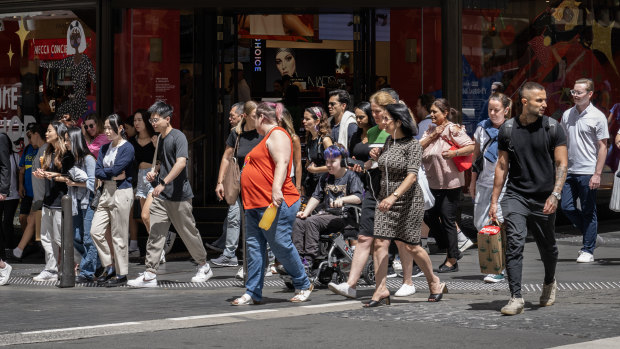Save articles for later
Add articles to your saved list and come back to them any time.
A surge of job seekers has lifted the participation rate to a record high but also pushed up unemployment to 3.9 per cent, signs economists say should reassure the Reserve Bank its efforts to slow the economy without sending it into a recession are working.
The jobs market remains strong with 61,500 more people in work in November, while the number of unemployed looking for work rose by 19,000. That lifted the participation rate to a new high of 67.2 per cent.
More than 61,000 people got jobs in November, while another 19,000 people looked for work.Credit: Louie Douvis
The rise in job hunters lifted the unemployment rate by 0.1 percentage points in November to 3.9 per cent – the highest level since the Reserve Bank began lifting interest rates last May.
Treasurer Jim Chalmers said the large number of new jobs created and the record-high participation rate meant the economy was well-placed to face next year’s economic challenges.
“These numbers give us some hope that the employers and the workers of this country are hanging in even under pressure,” he said.
“This does give us some confidence that we approach the uncertainties of 2024 from a position of strength.”
But shadow treasurer Angus Taylor said the jobs figures were another sign the economy was shuddering to a halt.
“This is not the economy we want going into Christmas. Households are hurting and now we see the employment market softening at a time when Australians really need every dollar they can to make ends meet.”
The RBA has lifted official interest rates to 4.35 per cent to help cool the economy and get inflation, which peaked around 8 per cent late last year, back down to its target range of 2-3 per cent.
The combination of high interest rates and persistently high inflation has hit households and business budgets, and as a result of the tougher economic conditions, the unemployment rate is expected to rise further.
The RBA forecasts it will reach 4 per cent by the middle of next year, while Treasury’s expectations are slightly higher at 4.25 per cent.
HSBC chief economist for Australia, New Zealand and global commodities Paul Bloxham said the strong jobs market has helped keep mortgage arrears and defaults low despite the rapid increase in interest rates, and was helping steer the country clear of a recession.
“In broad terms, this is the soft landing that has been hoped for,” he said.
Commonwealth Bank senior economist Belinda Allen said the rising underemployment rate, which gained 0.2 percentage points to 6.5 per cent, and a negligible change in monthly hours worked were signs the jobs market was softening.
At the same time, she pointed out that the working-age population was growing at a rapid pace – about 3 per cent over the past year – which could make it hard to keep the unemployment rate at its ultra-low level into next year.
“This means around 35,000 jobs are required to be added each month just to keep the unemployment rate steady,” she said.
“If migration slows, as intended, this number could slow in 2024, but still should outpace demand for labour.”
AMP deputy chief economist Diana Mousina said the slowing employment market would make the central bank cautious about lifting interest rates further.
“In our view, the December-quarter inflation data, which is released in late January, would need to show a decent upside surprise for the central bank to consider pulling the trigger again on another interest rate increase,” she said.
Cut through the noise of federal politics with news, views and expert analysis from Jacqueline Maley. Subscribers can sign up to our weekly Inside Politics newsletter here.
Most Viewed in Politics
From our partners
Source: Read Full Article



